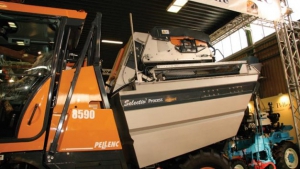
The grape harvester, on display at an Italian equipment show, can sort fruit in the field for MOG (material other than grapes), inferior berries, and de-stem clusters if desired
PHOTO BY MELISSA HANSEN
New harvesting technology makes grape harvesters gentler. They are also able to optically sort grapes during harvest to remove material other than grapes (MOG) and inferior berries, and can even de-stem when desired.
Mechanical harvesters pick 93 percent of Ste. Michelle’s 3,600 acres of wine grapes, according to Mike Means, director of operations. But he said that the company does have high-end wines made only from hand-picked grapes, such as the fruit used by its Col Solare winery on Red Mountain.
“At one time, Spring Valley Vineyards and Northstar wineries in Walla Walla used only hand-picked grapes,” he said. “But for the first time, last year, we machine-picked 16 acres of grapes for Northstar and picked a good chunk of grapes by machine at Spring Valley under hilly terrain.”
Keeping MOG out of mechanically picked grapes is key, Means said. “If you can keep the amount of MOG to a minimum and keep red grape berries whole, then you’ll keep the winemaker happy. With the newer harvester technology, fruit can be picked with much less maceration than in the past.”
Red Mountain
Kiona Vineyards and Winery is one of the few wineries on Red Mountain that uses mechanical harvesters. Winemaker Scott Williams says he prefers mechanically harvested grapes. Mechanical harvesters allow grapes to be picked at night, which Williams believes to be especially beneficial in the beginning of harvest when daytime temperatures can be in the 90s and 100s.
“With nighttime harvest, grapes are waiting for me when I arrive at the winery in the morning,” he said. “It takes me 30 minutes to get grapes in the press, and they are still cool from nighttime temperatures. When we used to hand pick, I was waiting all day for grapes.”
Kiona offers mechanically picked and crushed grapes as a service to small wineries that they sell grapes to. The wineries, many from western Washington, bring their fermenting containers to Kiona, and Williams loads the grapes directly in fermenting tanks.
Another advantage of nighttime harvest is that fruit shipped to western Washington can arrive at temperatures in the low 40s Fahrenheit instead of warming up from an afternoon transit time. Fruit temperatures are important when winemakers do a cold soak on their grapes.
Williams doesn’t see a difference in fruit quality between machine-harvested and hand-picked grapes. And for those who are concerned with being able to sort rot and diseased berries before crushing, his response is “Why are you buying grapes from a vineyard that has rot in it?”
Though Williams is a machine proponent, he cautions small wineries to consider the whole system before signing up for machine harvesting. “Smaller wineries must logistically be able to handle 25 tons of fruit at one time,” he said. “Harvesters want to visit a vineyard once and pick all at one time. In order for that to work for a small producer, he or she needs to develop a system where they can either handle that much fruit at once or work with the harvester to pick only what can be handled.”
Means estimated that picking grapes by hand costs up to $250 per ton in labor costs, compared to the labor cost of operating a mechanical grape harvester that’s around $35 to $40 per acre. He noted that the harvester cost does not include cost of the machinery. Custom harvesters charge around $35 per ton for Concords, with a minimum tonnage required. For wine grape harvesting, custom operators charge from $250 to $500 per acre, depending on advanced technologies of the machine, he said. The purchase cost of a new harvest machine, with sorting capabilities, can be around $350,000, though some can be used as a tool carrier for multiple functions.
Mechanically harvested grapes are becoming more accepted in the low- to mid-tier wines. But acceptance is still a problem with vintners of high-end wines. Means says that Ste. Michelle winemakers have been very pleased with the mechanically harvested grapes, but he’s quick to point out that the fruit is used in low- to mid-tier wine styles.
Winemakers are still convinced that grapes for high-tier wines need to be hand picked, he said. “We’re seeing machines that do a lot better job of picking than in the past. I think as technology advances, we’ll need to do more blind wine tastings to show winemakers there is little difference between machine and hand picked.”
Means and Williams spoke during the Washington State Grape Society’s annual meeting.

Excellent article.